Business Environment Analysis of Tesco: A Comprehensive Report
VerifiedAdded on 2023/01/05
|15
|3995
|99
Report
AI Summary
This report provides a comprehensive analysis of Tesco's business environment, examining both macro and micro environmental factors. It begins with a historical overview of Tesco, followed by a detailed PESTLE analysis that assesses the political, economic, social, technological, environmental, and legal factors influencing the company. The report then utilizes SWOT analysis to evaluate Tesco's strengths, weaknesses, opportunities, and threats, and the 5 Cs analysis to assess the company, collaborators, customers, competitors, and climate. Porter's Five Forces framework is also applied to understand the competitive landscape. Finally, the report explores market structure, the influence of demand and supply, and concludes with an overview of the challenges and opportunities facing Tesco. The report draws upon various frameworks to evaluate Tesco's performance within its business environment.
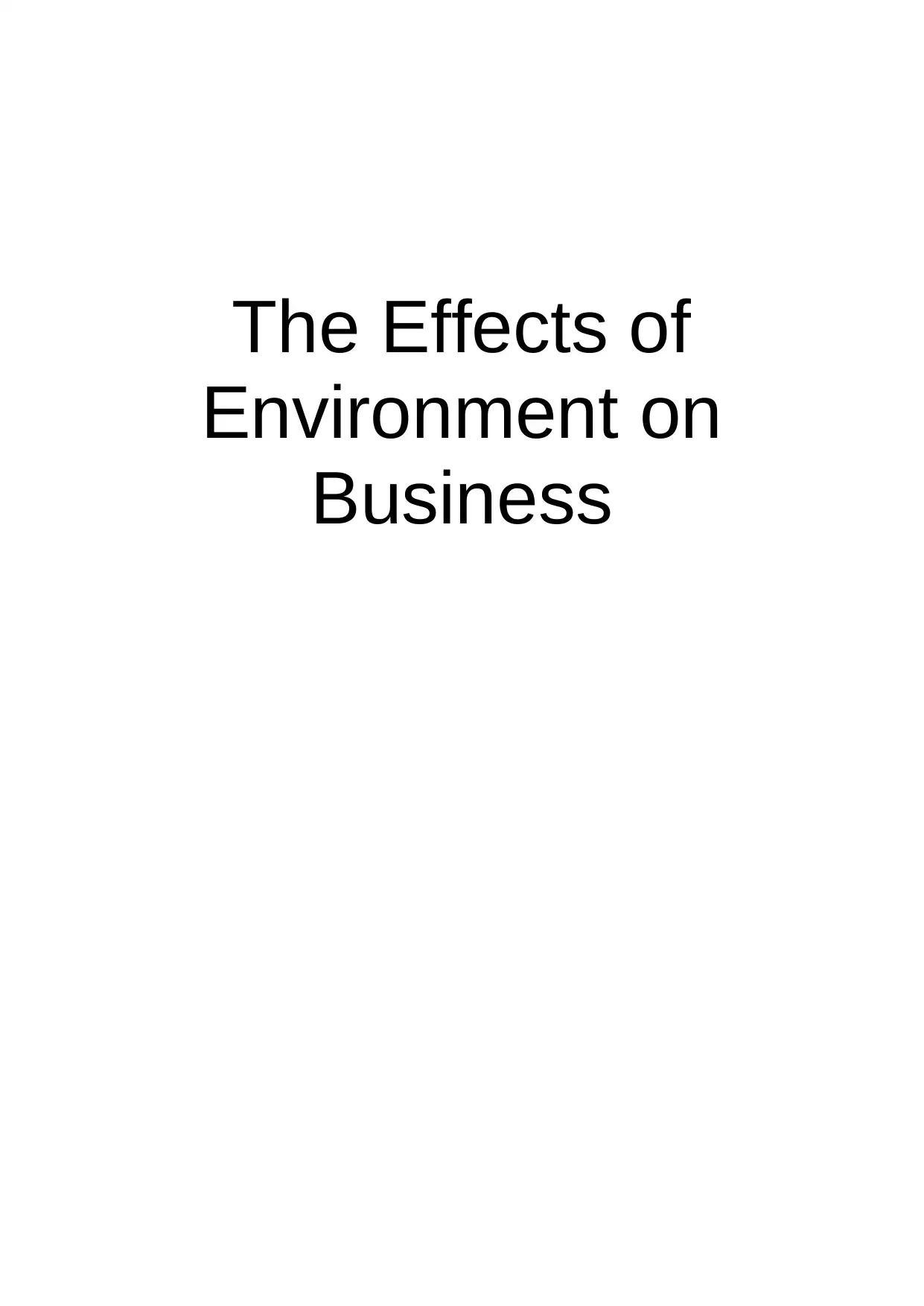
The Effects of
Environment on
Business
Environment on
Business
Paraphrase This Document
Need a fresh take? Get an instant paraphrase of this document with our AI Paraphraser

Table of Contents
Introduction...................................................................................................................3
History...........................................................................................................................3
Task 1...........................................................................................................................4
Pestle Analysis..........................................................................................................4
Culture.......................................................................................................................5
Corporate social responsibility..................................................................................6
Competitors...............................................................................................................6
Task 2...........................................................................................................................7
SWOT Analysis.........................................................................................................7
5 Cs analysis.............................................................................................................8
Porters Five forces..................................................................................................10
Task 3.........................................................................................................................11
Market structure......................................................................................................11
Influence of demand...............................................................................................11
Influence on supply.................................................................................................12
Conclusion..................................................................................................................14
References.................................................................................................................15
Introduction
Introduction...................................................................................................................3
History...........................................................................................................................3
Task 1...........................................................................................................................4
Pestle Analysis..........................................................................................................4
Culture.......................................................................................................................5
Corporate social responsibility..................................................................................6
Competitors...............................................................................................................6
Task 2...........................................................................................................................7
SWOT Analysis.........................................................................................................7
5 Cs analysis.............................................................................................................8
Porters Five forces..................................................................................................10
Task 3.........................................................................................................................11
Market structure......................................................................................................11
Influence of demand...............................................................................................11
Influence on supply.................................................................................................12
Conclusion..................................................................................................................14
References.................................................................................................................15
Introduction

The following report consists of an analysis on Tesco. There are a number of
factors which have been influencing a business environment such as macro and
micro environmental factors (Prajogo and Oke, 2016). The following report consists
of different frameworks which are assessing macro as well as micro environment of
business. Assessment of various changes that are brought in market for Tesco along
with an assessment of their competitors is also provided in the report. There are
framework like Pestle analysis, Swot analysis, 5 c’s and Porter’s five forces models
used.
History
Tesco was founded by Jack Cohen in 1919. It was started as a group of
market stalls in London. The name Tesco’s first appeared in 1924 after a shipment of
tea was purchased by Cohen. The business expanded rapidly and by 1939 there
were already hundred Tesco stores throughout the country. In early 1990s Tesco
started expanding globally with operations in a number of other countries throughout
the world.Tesco have now successfully diversified into a number of areas of retailing
such as books, clothing, furniture, toys, software, financial services and a number of
different internet services (Amponsah, 2018). Tesco have also repositioned
themselves as high volume and low-cost retailer in order to attract a range of
different social groups with low-cost value.
Task 1
Pestle Analysis
There are a number of external factors that are affecting operations and
activities in Tesco. Below mentioned are these external factors:
factors which have been influencing a business environment such as macro and
micro environmental factors (Prajogo and Oke, 2016). The following report consists
of different frameworks which are assessing macro as well as micro environment of
business. Assessment of various changes that are brought in market for Tesco along
with an assessment of their competitors is also provided in the report. There are
framework like Pestle analysis, Swot analysis, 5 c’s and Porter’s five forces models
used.
History
Tesco was founded by Jack Cohen in 1919. It was started as a group of
market stalls in London. The name Tesco’s first appeared in 1924 after a shipment of
tea was purchased by Cohen. The business expanded rapidly and by 1939 there
were already hundred Tesco stores throughout the country. In early 1990s Tesco
started expanding globally with operations in a number of other countries throughout
the world.Tesco have now successfully diversified into a number of areas of retailing
such as books, clothing, furniture, toys, software, financial services and a number of
different internet services (Amponsah, 2018). Tesco have also repositioned
themselves as high volume and low-cost retailer in order to attract a range of
different social groups with low-cost value.
Task 1
Pestle Analysis
There are a number of external factors that are affecting operations and
activities in Tesco. Below mentioned are these external factors:
⊘ This is a preview!⊘
Do you want full access?
Subscribe today to unlock all pages.

Trusted by 1+ million students worldwide
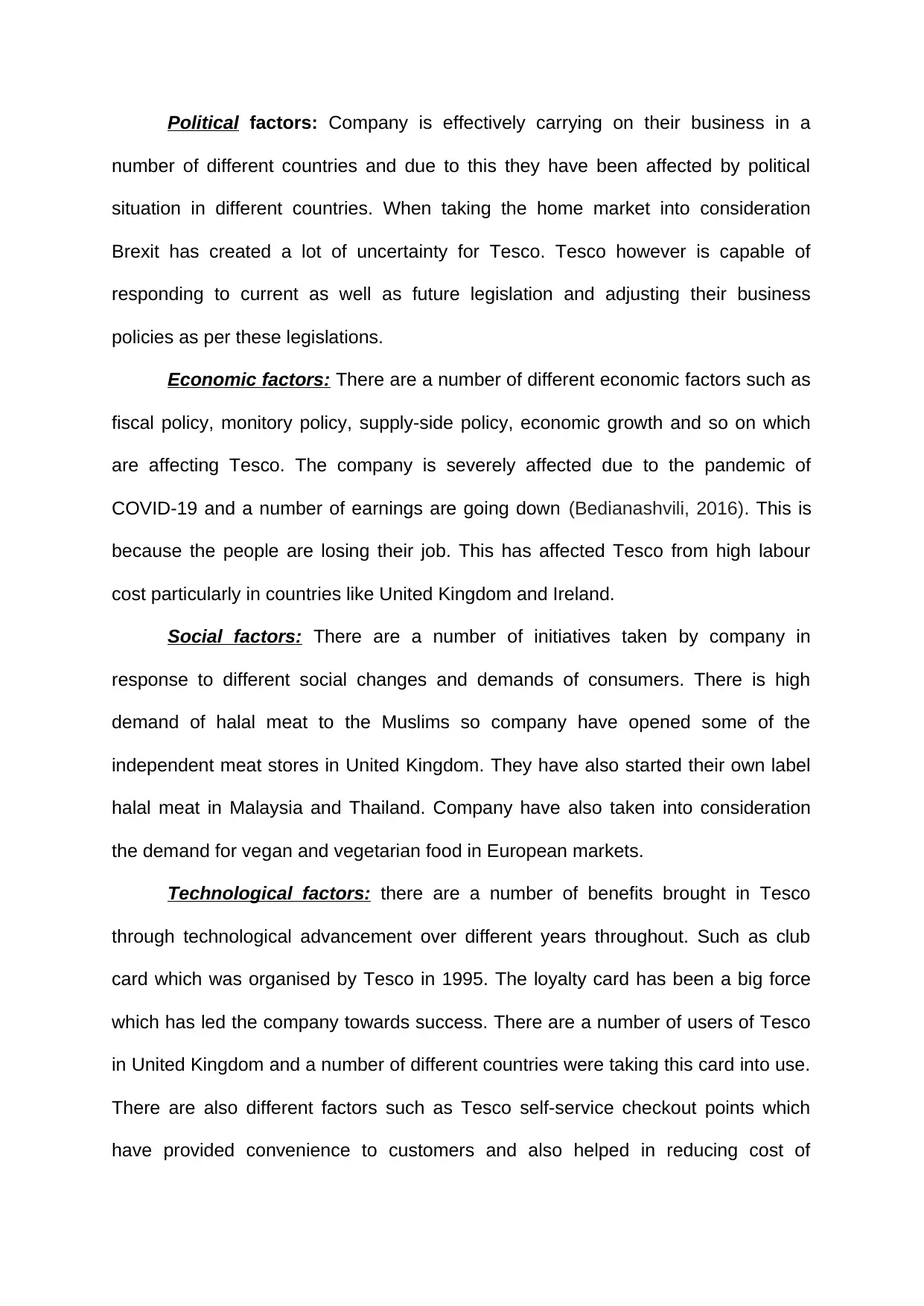
Political factors: Company is effectively carrying on their business in a
number of different countries and due to this they have been affected by political
situation in different countries. When taking the home market into consideration
Brexit has created a lot of uncertainty for Tesco. Tesco however is capable of
responding to current as well as future legislation and adjusting their business
policies as per these legislations.
Economic factors: There are a number of different economic factors such as
fiscal policy, monitory policy, supply-side policy, economic growth and so on which
are affecting Tesco. The company is severely affected due to the pandemic of
COVID-19 and a number of earnings are going down (Bedianashvili, 2016). This is
because the people are losing their job. This has affected Tesco from high labour
cost particularly in countries like United Kingdom and Ireland.
Social factors: There are a number of initiatives taken by company in
response to different social changes and demands of consumers. There is high
demand of halal meat to the Muslims so company have opened some of the
independent meat stores in United Kingdom. They have also started their own label
halal meat in Malaysia and Thailand. Company have also taken into consideration
the demand for vegan and vegetarian food in European markets.
Technological factors: there are a number of benefits brought in Tesco
through technological advancement over different years throughout. Such as club
card which was organised by Tesco in 1995. The loyalty card has been a big force
which has led the company towards success. There are a number of users of Tesco
in United Kingdom and a number of different countries were taking this card into use.
There are also different factors such as Tesco self-service checkout points which
have provided convenience to customers and also helped in reducing cost of
number of different countries and due to this they have been affected by political
situation in different countries. When taking the home market into consideration
Brexit has created a lot of uncertainty for Tesco. Tesco however is capable of
responding to current as well as future legislation and adjusting their business
policies as per these legislations.
Economic factors: There are a number of different economic factors such as
fiscal policy, monitory policy, supply-side policy, economic growth and so on which
are affecting Tesco. The company is severely affected due to the pandemic of
COVID-19 and a number of earnings are going down (Bedianashvili, 2016). This is
because the people are losing their job. This has affected Tesco from high labour
cost particularly in countries like United Kingdom and Ireland.
Social factors: There are a number of initiatives taken by company in
response to different social changes and demands of consumers. There is high
demand of halal meat to the Muslims so company have opened some of the
independent meat stores in United Kingdom. They have also started their own label
halal meat in Malaysia and Thailand. Company have also taken into consideration
the demand for vegan and vegetarian food in European markets.
Technological factors: there are a number of benefits brought in Tesco
through technological advancement over different years throughout. Such as club
card which was organised by Tesco in 1995. The loyalty card has been a big force
which has led the company towards success. There are a number of users of Tesco
in United Kingdom and a number of different countries were taking this card into use.
There are also different factors such as Tesco self-service checkout points which
have provided convenience to customers and also helped in reducing cost of
Paraphrase This Document
Need a fresh take? Get an instant paraphrase of this document with our AI Paraphraser
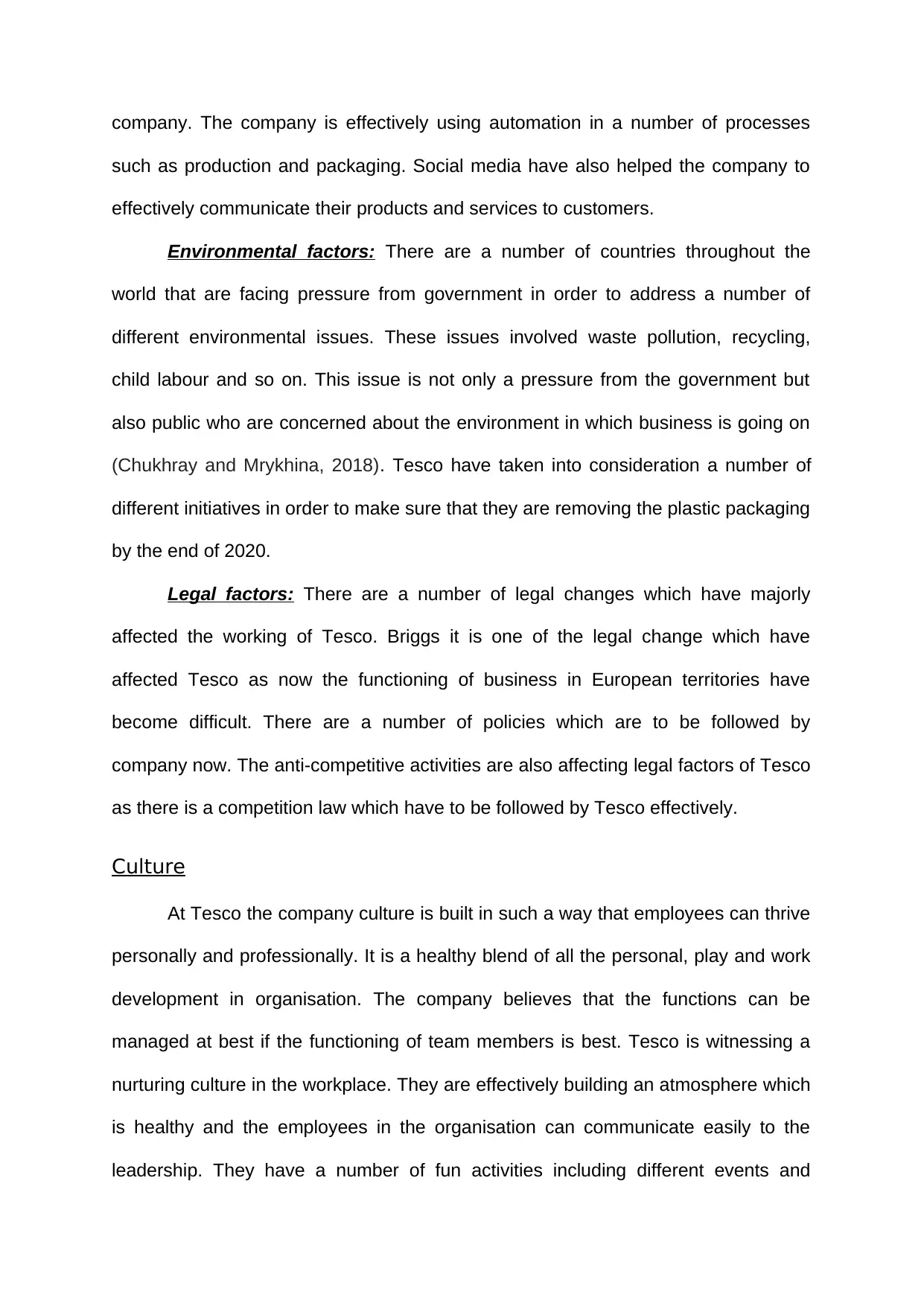
company. The company is effectively using automation in a number of processes
such as production and packaging. Social media have also helped the company to
effectively communicate their products and services to customers.
Environmental factors: There are a number of countries throughout the
world that are facing pressure from government in order to address a number of
different environmental issues. These issues involved waste pollution, recycling,
child labour and so on. This issue is not only a pressure from the government but
also public who are concerned about the environment in which business is going on
(Chukhray and Mrykhina, 2018). Tesco have taken into consideration a number of
different initiatives in order to make sure that they are removing the plastic packaging
by the end of 2020.
Legal factors: There are a number of legal changes which have majorly
affected the working of Tesco. Briggs it is one of the legal change which have
affected Tesco as now the functioning of business in European territories have
become difficult. There are a number of policies which are to be followed by
company now. The anti-competitive activities are also affecting legal factors of Tesco
as there is a competition law which have to be followed by Tesco effectively.
Culture
At Tesco the company culture is built in such a way that employees can thrive
personally and professionally. It is a healthy blend of all the personal, play and work
development in organisation. The company believes that the functions can be
managed at best if the functioning of team members is best. Tesco is witnessing a
nurturing culture in the workplace. They are effectively building an atmosphere which
is healthy and the employees in the organisation can communicate easily to the
leadership. They have a number of fun activities including different events and
such as production and packaging. Social media have also helped the company to
effectively communicate their products and services to customers.
Environmental factors: There are a number of countries throughout the
world that are facing pressure from government in order to address a number of
different environmental issues. These issues involved waste pollution, recycling,
child labour and so on. This issue is not only a pressure from the government but
also public who are concerned about the environment in which business is going on
(Chukhray and Mrykhina, 2018). Tesco have taken into consideration a number of
different initiatives in order to make sure that they are removing the plastic packaging
by the end of 2020.
Legal factors: There are a number of legal changes which have majorly
affected the working of Tesco. Briggs it is one of the legal change which have
affected Tesco as now the functioning of business in European territories have
become difficult. There are a number of policies which are to be followed by
company now. The anti-competitive activities are also affecting legal factors of Tesco
as there is a competition law which have to be followed by Tesco effectively.
Culture
At Tesco the company culture is built in such a way that employees can thrive
personally and professionally. It is a healthy blend of all the personal, play and work
development in organisation. The company believes that the functions can be
managed at best if the functioning of team members is best. Tesco is witnessing a
nurturing culture in the workplace. They are effectively building an atmosphere which
is healthy and the employees in the organisation can communicate easily to the
leadership. They have a number of fun activities including different events and
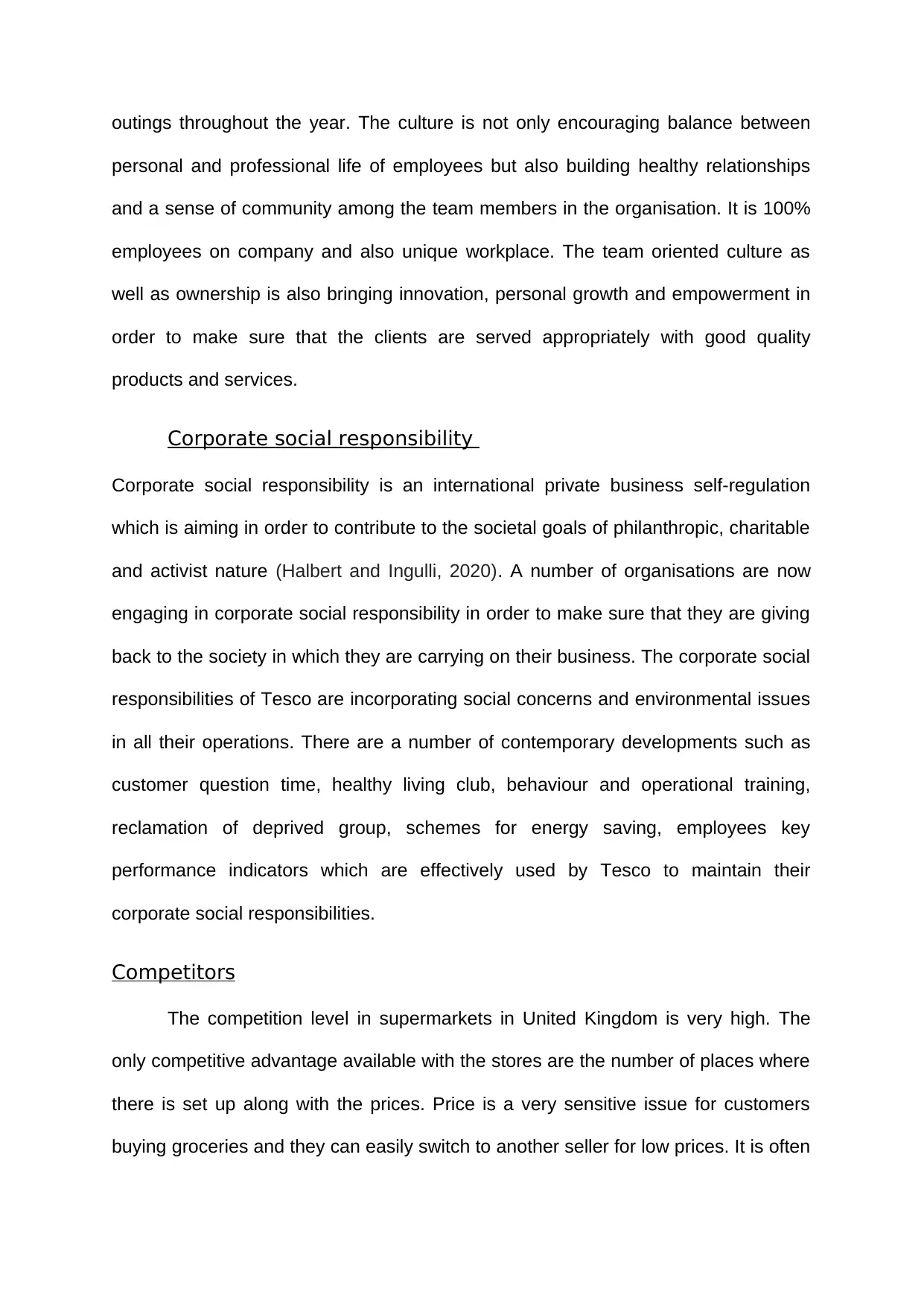
outings throughout the year. The culture is not only encouraging balance between
personal and professional life of employees but also building healthy relationships
and a sense of community among the team members in the organisation. It is 100%
employees on company and also unique workplace. The team oriented culture as
well as ownership is also bringing innovation, personal growth and empowerment in
order to make sure that the clients are served appropriately with good quality
products and services.
Corporate social responsibility
Corporate social responsibility is an international private business self-regulation
which is aiming in order to contribute to the societal goals of philanthropic, charitable
and activist nature (Halbert and Ingulli, 2020). A number of organisations are now
engaging in corporate social responsibility in order to make sure that they are giving
back to the society in which they are carrying on their business. The corporate social
responsibilities of Tesco are incorporating social concerns and environmental issues
in all their operations. There are a number of contemporary developments such as
customer question time, healthy living club, behaviour and operational training,
reclamation of deprived group, schemes for energy saving, employees key
performance indicators which are effectively used by Tesco to maintain their
corporate social responsibilities.
Competitors
The competition level in supermarkets in United Kingdom is very high. The
only competitive advantage available with the stores are the number of places where
there is set up along with the prices. Price is a very sensitive issue for customers
buying groceries and they can easily switch to another seller for low prices. It is often
personal and professional life of employees but also building healthy relationships
and a sense of community among the team members in the organisation. It is 100%
employees on company and also unique workplace. The team oriented culture as
well as ownership is also bringing innovation, personal growth and empowerment in
order to make sure that the clients are served appropriately with good quality
products and services.
Corporate social responsibility
Corporate social responsibility is an international private business self-regulation
which is aiming in order to contribute to the societal goals of philanthropic, charitable
and activist nature (Halbert and Ingulli, 2020). A number of organisations are now
engaging in corporate social responsibility in order to make sure that they are giving
back to the society in which they are carrying on their business. The corporate social
responsibilities of Tesco are incorporating social concerns and environmental issues
in all their operations. There are a number of contemporary developments such as
customer question time, healthy living club, behaviour and operational training,
reclamation of deprived group, schemes for energy saving, employees key
performance indicators which are effectively used by Tesco to maintain their
corporate social responsibilities.
Competitors
The competition level in supermarkets in United Kingdom is very high. The
only competitive advantage available with the stores are the number of places where
there is set up along with the prices. Price is a very sensitive issue for customers
buying groceries and they can easily switch to another seller for low prices. It is often
⊘ This is a preview!⊘
Do you want full access?
Subscribe today to unlock all pages.

Trusted by 1+ million students worldwide
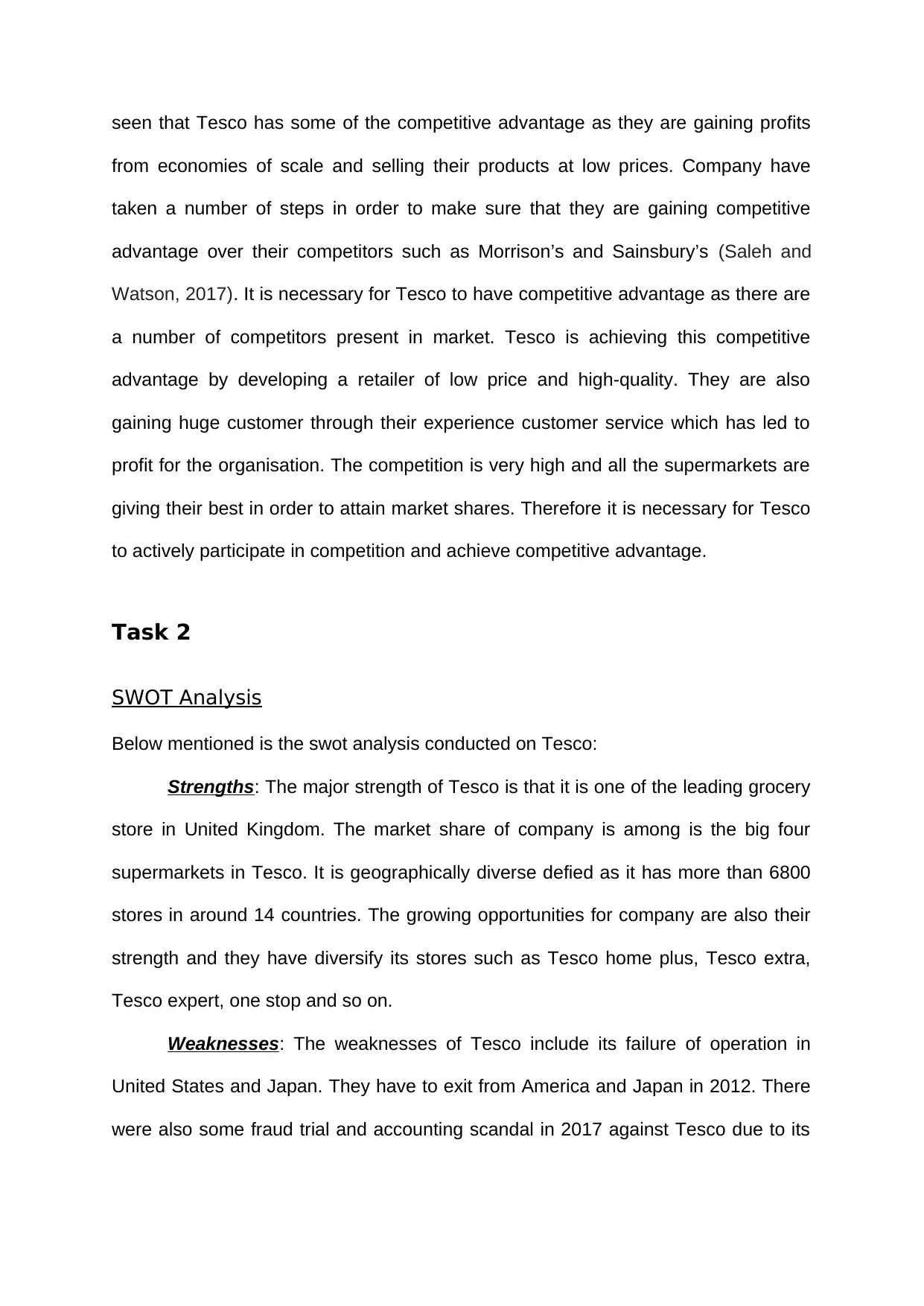
seen that Tesco has some of the competitive advantage as they are gaining profits
from economies of scale and selling their products at low prices. Company have
taken a number of steps in order to make sure that they are gaining competitive
advantage over their competitors such as Morrison’s and Sainsbury’s (Saleh and
Watson, 2017). It is necessary for Tesco to have competitive advantage as there are
a number of competitors present in market. Tesco is achieving this competitive
advantage by developing a retailer of low price and high-quality. They are also
gaining huge customer through their experience customer service which has led to
profit for the organisation. The competition is very high and all the supermarkets are
giving their best in order to attain market shares. Therefore it is necessary for Tesco
to actively participate in competition and achieve competitive advantage.
Task 2
SWOT Analysis
Below mentioned is the swot analysis conducted on Tesco:
Strengths: The major strength of Tesco is that it is one of the leading grocery
store in United Kingdom. The market share of company is among is the big four
supermarkets in Tesco. It is geographically diverse defied as it has more than 6800
stores in around 14 countries. The growing opportunities for company are also their
strength and they have diversify its stores such as Tesco home plus, Tesco extra,
Tesco expert, one stop and so on.
Weaknesses: The weaknesses of Tesco include its failure of operation in
United States and Japan. They have to exit from America and Japan in 2012. There
were also some fraud trial and accounting scandal in 2017 against Tesco due to its
from economies of scale and selling their products at low prices. Company have
taken a number of steps in order to make sure that they are gaining competitive
advantage over their competitors such as Morrison’s and Sainsbury’s (Saleh and
Watson, 2017). It is necessary for Tesco to have competitive advantage as there are
a number of competitors present in market. Tesco is achieving this competitive
advantage by developing a retailer of low price and high-quality. They are also
gaining huge customer through their experience customer service which has led to
profit for the organisation. The competition is very high and all the supermarkets are
giving their best in order to attain market shares. Therefore it is necessary for Tesco
to actively participate in competition and achieve competitive advantage.
Task 2
SWOT Analysis
Below mentioned is the swot analysis conducted on Tesco:
Strengths: The major strength of Tesco is that it is one of the leading grocery
store in United Kingdom. The market share of company is among is the big four
supermarkets in Tesco. It is geographically diverse defied as it has more than 6800
stores in around 14 countries. The growing opportunities for company are also their
strength and they have diversify its stores such as Tesco home plus, Tesco extra,
Tesco expert, one stop and so on.
Weaknesses: The weaknesses of Tesco include its failure of operation in
United States and Japan. They have to exit from America and Japan in 2012. There
were also some fraud trial and accounting scandal in 2017 against Tesco due to its
Paraphrase This Document
Need a fresh take? Get an instant paraphrase of this document with our AI Paraphraser
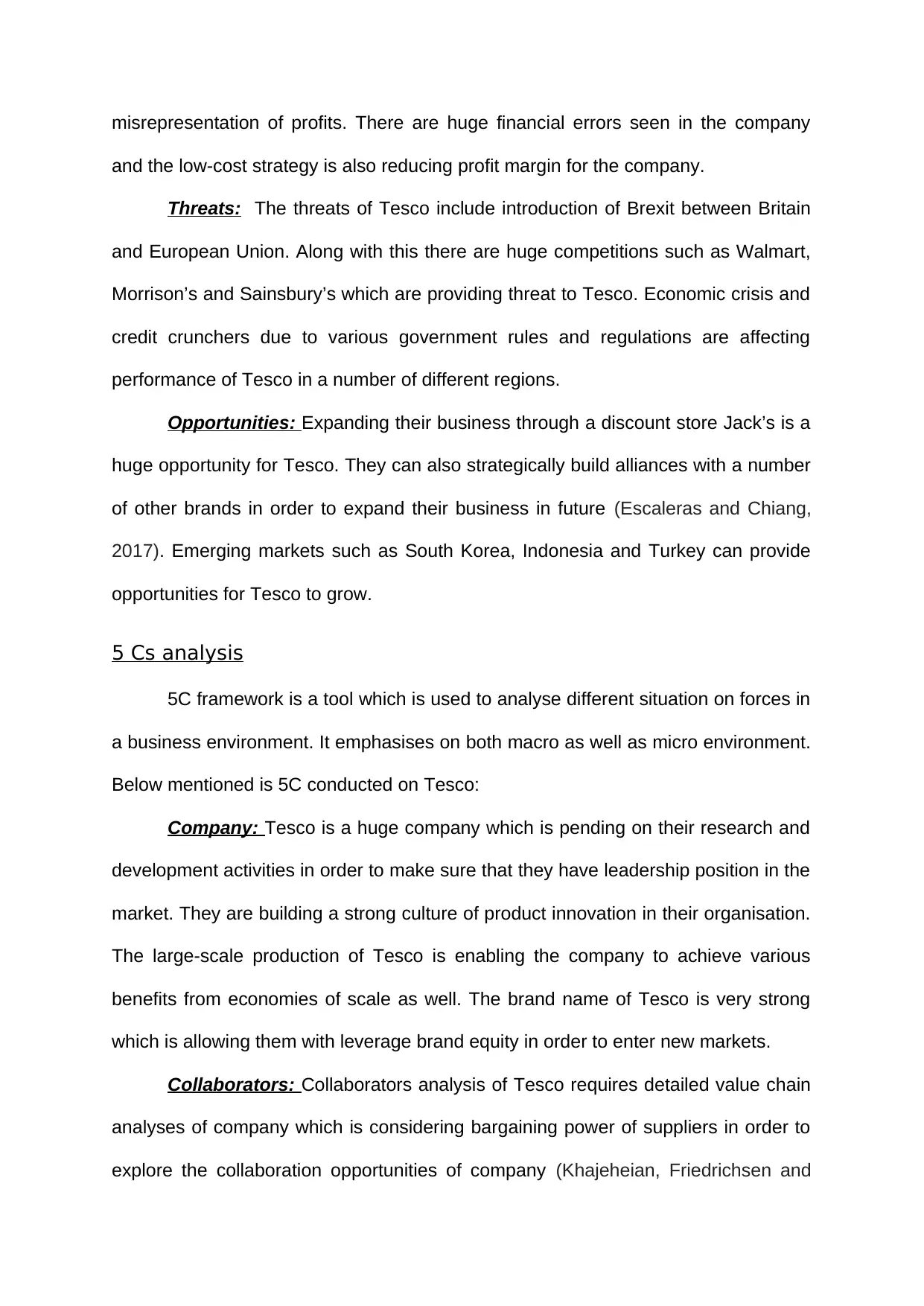
misrepresentation of profits. There are huge financial errors seen in the company
and the low-cost strategy is also reducing profit margin for the company.
Threats: The threats of Tesco include introduction of Brexit between Britain
and European Union. Along with this there are huge competitions such as Walmart,
Morrison’s and Sainsbury’s which are providing threat to Tesco. Economic crisis and
credit crunchers due to various government rules and regulations are affecting
performance of Tesco in a number of different regions.
Opportunities: Expanding their business through a discount store Jack’s is a
huge opportunity for Tesco. They can also strategically build alliances with a number
of other brands in order to expand their business in future (Escaleras and Chiang,
2017). Emerging markets such as South Korea, Indonesia and Turkey can provide
opportunities for Tesco to grow.
5 Cs analysis
5C framework is a tool which is used to analyse different situation on forces in
a business environment. It emphasises on both macro as well as micro environment.
Below mentioned is 5C conducted on Tesco:
Company: Tesco is a huge company which is pending on their research and
development activities in order to make sure that they have leadership position in the
market. They are building a strong culture of product innovation in their organisation.
The large-scale production of Tesco is enabling the company to achieve various
benefits from economies of scale as well. The brand name of Tesco is very strong
which is allowing them with leverage brand equity in order to enter new markets.
Collaborators: Collaborators analysis of Tesco requires detailed value chain
analyses of company which is considering bargaining power of suppliers in order to
explore the collaboration opportunities of company (Khajeheian, Friedrichsen and
and the low-cost strategy is also reducing profit margin for the company.
Threats: The threats of Tesco include introduction of Brexit between Britain
and European Union. Along with this there are huge competitions such as Walmart,
Morrison’s and Sainsbury’s which are providing threat to Tesco. Economic crisis and
credit crunchers due to various government rules and regulations are affecting
performance of Tesco in a number of different regions.
Opportunities: Expanding their business through a discount store Jack’s is a
huge opportunity for Tesco. They can also strategically build alliances with a number
of other brands in order to expand their business in future (Escaleras and Chiang,
2017). Emerging markets such as South Korea, Indonesia and Turkey can provide
opportunities for Tesco to grow.
5 Cs analysis
5C framework is a tool which is used to analyse different situation on forces in
a business environment. It emphasises on both macro as well as micro environment.
Below mentioned is 5C conducted on Tesco:
Company: Tesco is a huge company which is pending on their research and
development activities in order to make sure that they have leadership position in the
market. They are building a strong culture of product innovation in their organisation.
The large-scale production of Tesco is enabling the company to achieve various
benefits from economies of scale as well. The brand name of Tesco is very strong
which is allowing them with leverage brand equity in order to enter new markets.
Collaborators: Collaborators analysis of Tesco requires detailed value chain
analyses of company which is considering bargaining power of suppliers in order to
explore the collaboration opportunities of company (Khajeheian, Friedrichsen and
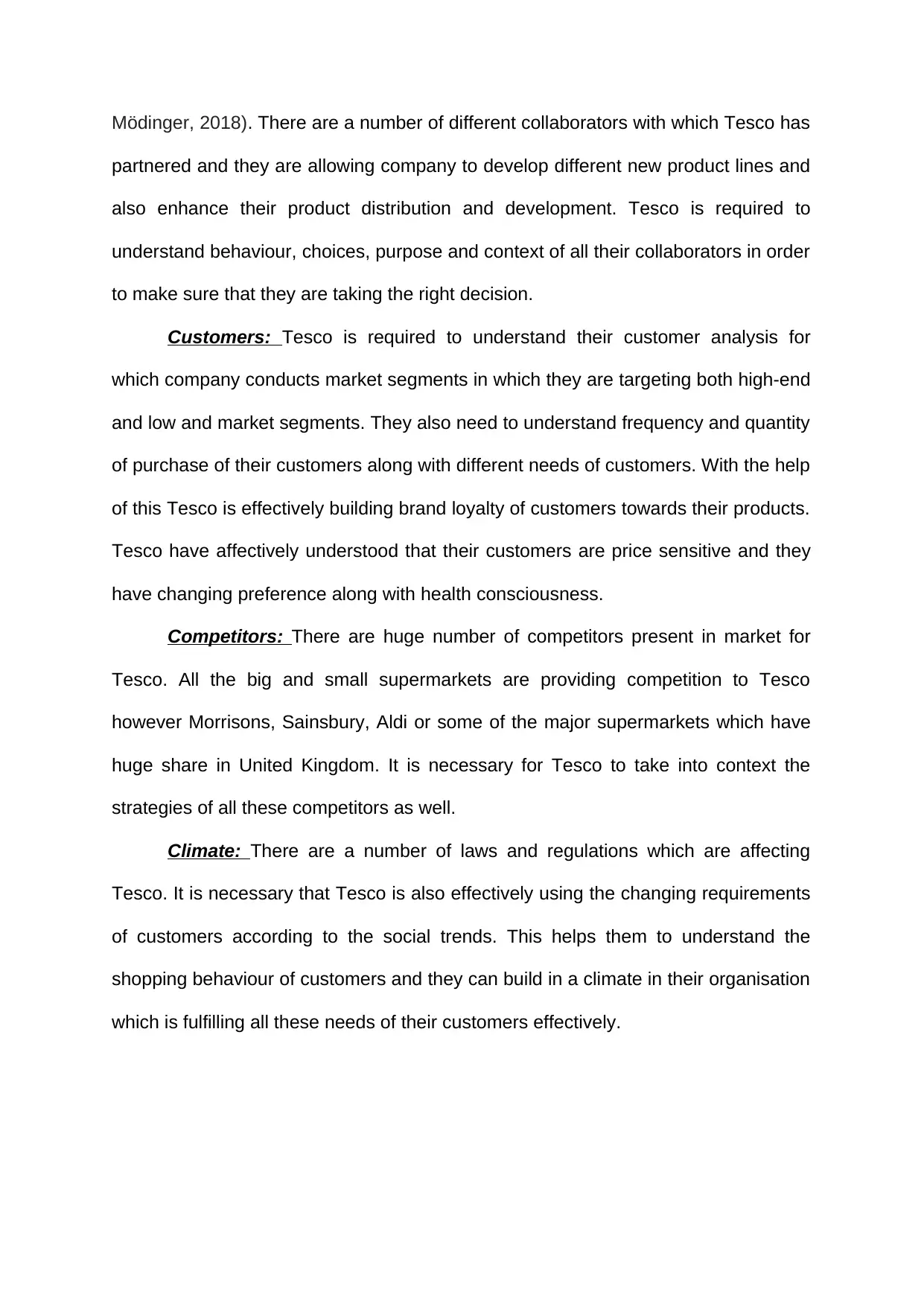
Mödinger, 2018). There are a number of different collaborators with which Tesco has
partnered and they are allowing company to develop different new product lines and
also enhance their product distribution and development. Tesco is required to
understand behaviour, choices, purpose and context of all their collaborators in order
to make sure that they are taking the right decision.
Customers: Tesco is required to understand their customer analysis for
which company conducts market segments in which they are targeting both high-end
and low and market segments. They also need to understand frequency and quantity
of purchase of their customers along with different needs of customers. With the help
of this Tesco is effectively building brand loyalty of customers towards their products.
Tesco have affectively understood that their customers are price sensitive and they
have changing preference along with health consciousness.
Competitors: There are huge number of competitors present in market for
Tesco. All the big and small supermarkets are providing competition to Tesco
however Morrisons, Sainsbury, Aldi or some of the major supermarkets which have
huge share in United Kingdom. It is necessary for Tesco to take into context the
strategies of all these competitors as well.
Climate: There are a number of laws and regulations which are affecting
Tesco. It is necessary that Tesco is also effectively using the changing requirements
of customers according to the social trends. This helps them to understand the
shopping behaviour of customers and they can build in a climate in their organisation
which is fulfilling all these needs of their customers effectively.
partnered and they are allowing company to develop different new product lines and
also enhance their product distribution and development. Tesco is required to
understand behaviour, choices, purpose and context of all their collaborators in order
to make sure that they are taking the right decision.
Customers: Tesco is required to understand their customer analysis for
which company conducts market segments in which they are targeting both high-end
and low and market segments. They also need to understand frequency and quantity
of purchase of their customers along with different needs of customers. With the help
of this Tesco is effectively building brand loyalty of customers towards their products.
Tesco have affectively understood that their customers are price sensitive and they
have changing preference along with health consciousness.
Competitors: There are huge number of competitors present in market for
Tesco. All the big and small supermarkets are providing competition to Tesco
however Morrisons, Sainsbury, Aldi or some of the major supermarkets which have
huge share in United Kingdom. It is necessary for Tesco to take into context the
strategies of all these competitors as well.
Climate: There are a number of laws and regulations which are affecting
Tesco. It is necessary that Tesco is also effectively using the changing requirements
of customers according to the social trends. This helps them to understand the
shopping behaviour of customers and they can build in a climate in their organisation
which is fulfilling all these needs of their customers effectively.
⊘ This is a preview!⊘
Do you want full access?
Subscribe today to unlock all pages.

Trusted by 1+ million students worldwide
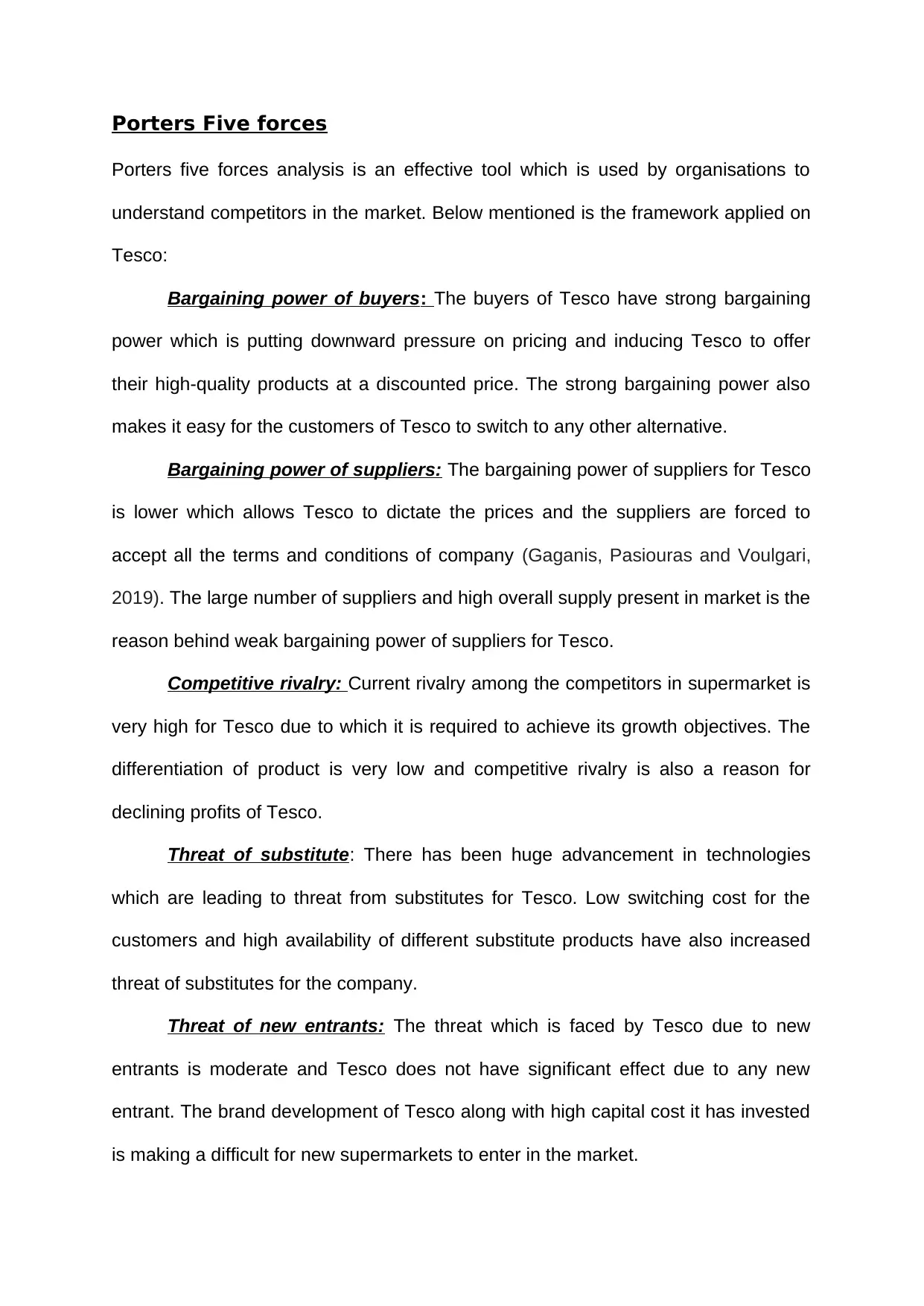
Porters Five forces
Porters five forces analysis is an effective tool which is used by organisations to
understand competitors in the market. Below mentioned is the framework applied on
Tesco:
Bargaining power of buyers: The buyers of Tesco have strong bargaining
power which is putting downward pressure on pricing and inducing Tesco to offer
their high-quality products at a discounted price. The strong bargaining power also
makes it easy for the customers of Tesco to switch to any other alternative.
Bargaining power of suppliers: The bargaining power of suppliers for Tesco
is lower which allows Tesco to dictate the prices and the suppliers are forced to
accept all the terms and conditions of company (Gaganis, Pasiouras and Voulgari,
2019). The large number of suppliers and high overall supply present in market is the
reason behind weak bargaining power of suppliers for Tesco.
Competitive rivalry: Current rivalry among the competitors in supermarket is
very high for Tesco due to which it is required to achieve its growth objectives. The
differentiation of product is very low and competitive rivalry is also a reason for
declining profits of Tesco.
Threat of substitute: There has been huge advancement in technologies
which are leading to threat from substitutes for Tesco. Low switching cost for the
customers and high availability of different substitute products have also increased
threat of substitutes for the company.
Threat of new entrants: The threat which is faced by Tesco due to new
entrants is moderate and Tesco does not have significant effect due to any new
entrant. The brand development of Tesco along with high capital cost it has invested
is making a difficult for new supermarkets to enter in the market.
Porters five forces analysis is an effective tool which is used by organisations to
understand competitors in the market. Below mentioned is the framework applied on
Tesco:
Bargaining power of buyers: The buyers of Tesco have strong bargaining
power which is putting downward pressure on pricing and inducing Tesco to offer
their high-quality products at a discounted price. The strong bargaining power also
makes it easy for the customers of Tesco to switch to any other alternative.
Bargaining power of suppliers: The bargaining power of suppliers for Tesco
is lower which allows Tesco to dictate the prices and the suppliers are forced to
accept all the terms and conditions of company (Gaganis, Pasiouras and Voulgari,
2019). The large number of suppliers and high overall supply present in market is the
reason behind weak bargaining power of suppliers for Tesco.
Competitive rivalry: Current rivalry among the competitors in supermarket is
very high for Tesco due to which it is required to achieve its growth objectives. The
differentiation of product is very low and competitive rivalry is also a reason for
declining profits of Tesco.
Threat of substitute: There has been huge advancement in technologies
which are leading to threat from substitutes for Tesco. Low switching cost for the
customers and high availability of different substitute products have also increased
threat of substitutes for the company.
Threat of new entrants: The threat which is faced by Tesco due to new
entrants is moderate and Tesco does not have significant effect due to any new
entrant. The brand development of Tesco along with high capital cost it has invested
is making a difficult for new supermarkets to enter in the market.
Paraphrase This Document
Need a fresh take? Get an instant paraphrase of this document with our AI Paraphraser
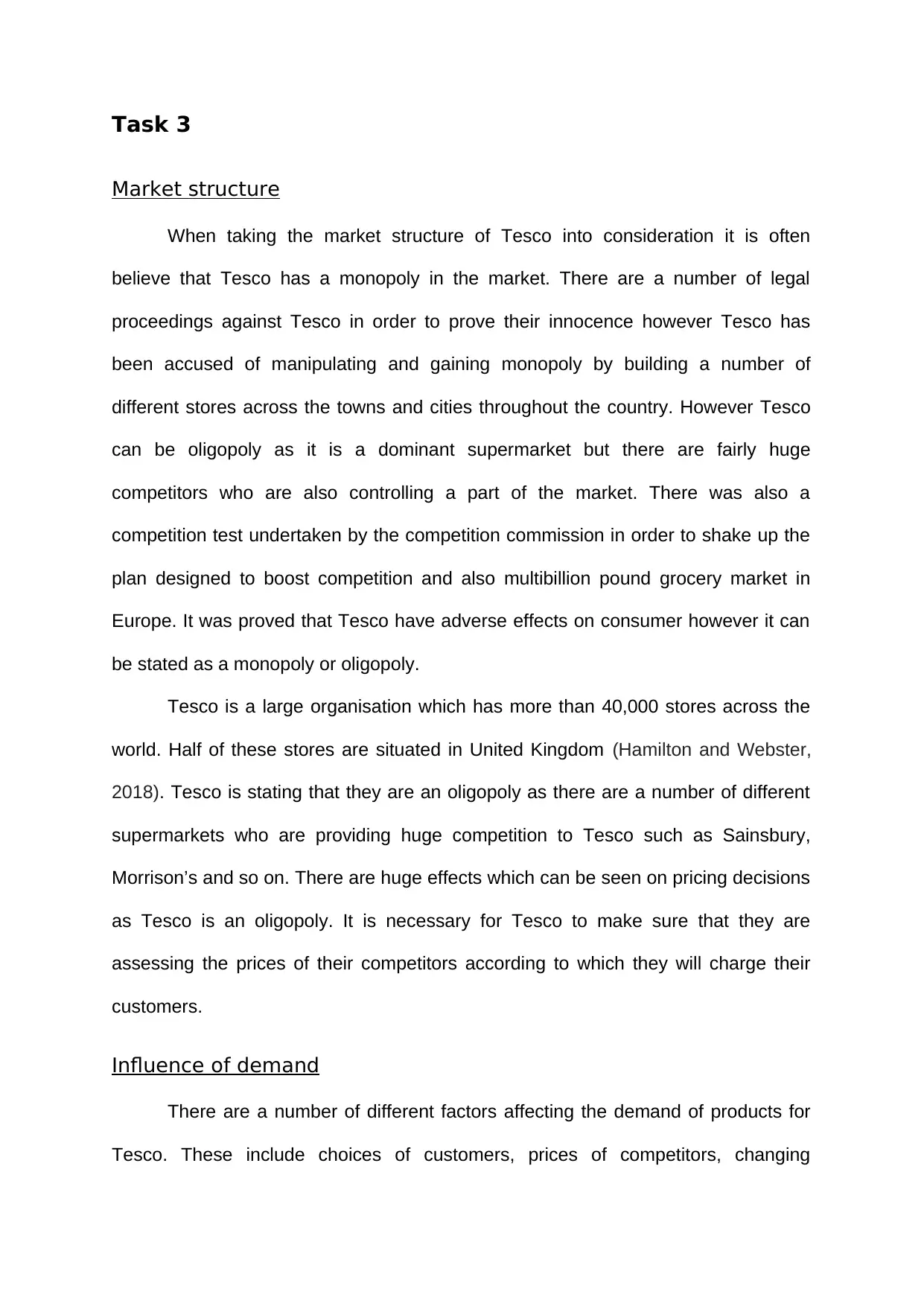
Task 3
Market structure
When taking the market structure of Tesco into consideration it is often
believe that Tesco has a monopoly in the market. There are a number of legal
proceedings against Tesco in order to prove their innocence however Tesco has
been accused of manipulating and gaining monopoly by building a number of
different stores across the towns and cities throughout the country. However Tesco
can be oligopoly as it is a dominant supermarket but there are fairly huge
competitors who are also controlling a part of the market. There was also a
competition test undertaken by the competition commission in order to shake up the
plan designed to boost competition and also multibillion pound grocery market in
Europe. It was proved that Tesco have adverse effects on consumer however it can
be stated as a monopoly or oligopoly.
Tesco is a large organisation which has more than 40,000 stores across the
world. Half of these stores are situated in United Kingdom (Hamilton and Webster,
2018). Tesco is stating that they are an oligopoly as there are a number of different
supermarkets who are providing huge competition to Tesco such as Sainsbury,
Morrison’s and so on. There are huge effects which can be seen on pricing decisions
as Tesco is an oligopoly. It is necessary for Tesco to make sure that they are
assessing the prices of their competitors according to which they will charge their
customers.
Influence of demand
There are a number of different factors affecting the demand of products for
Tesco. These include choices of customers, prices of competitors, changing
Market structure
When taking the market structure of Tesco into consideration it is often
believe that Tesco has a monopoly in the market. There are a number of legal
proceedings against Tesco in order to prove their innocence however Tesco has
been accused of manipulating and gaining monopoly by building a number of
different stores across the towns and cities throughout the country. However Tesco
can be oligopoly as it is a dominant supermarket but there are fairly huge
competitors who are also controlling a part of the market. There was also a
competition test undertaken by the competition commission in order to shake up the
plan designed to boost competition and also multibillion pound grocery market in
Europe. It was proved that Tesco have adverse effects on consumer however it can
be stated as a monopoly or oligopoly.
Tesco is a large organisation which has more than 40,000 stores across the
world. Half of these stores are situated in United Kingdom (Hamilton and Webster,
2018). Tesco is stating that they are an oligopoly as there are a number of different
supermarkets who are providing huge competition to Tesco such as Sainsbury,
Morrison’s and so on. There are huge effects which can be seen on pricing decisions
as Tesco is an oligopoly. It is necessary for Tesco to make sure that they are
assessing the prices of their competitors according to which they will charge their
customers.
Influence of demand
There are a number of different factors affecting the demand of products for
Tesco. These include choices of customers, prices of competitors, changing
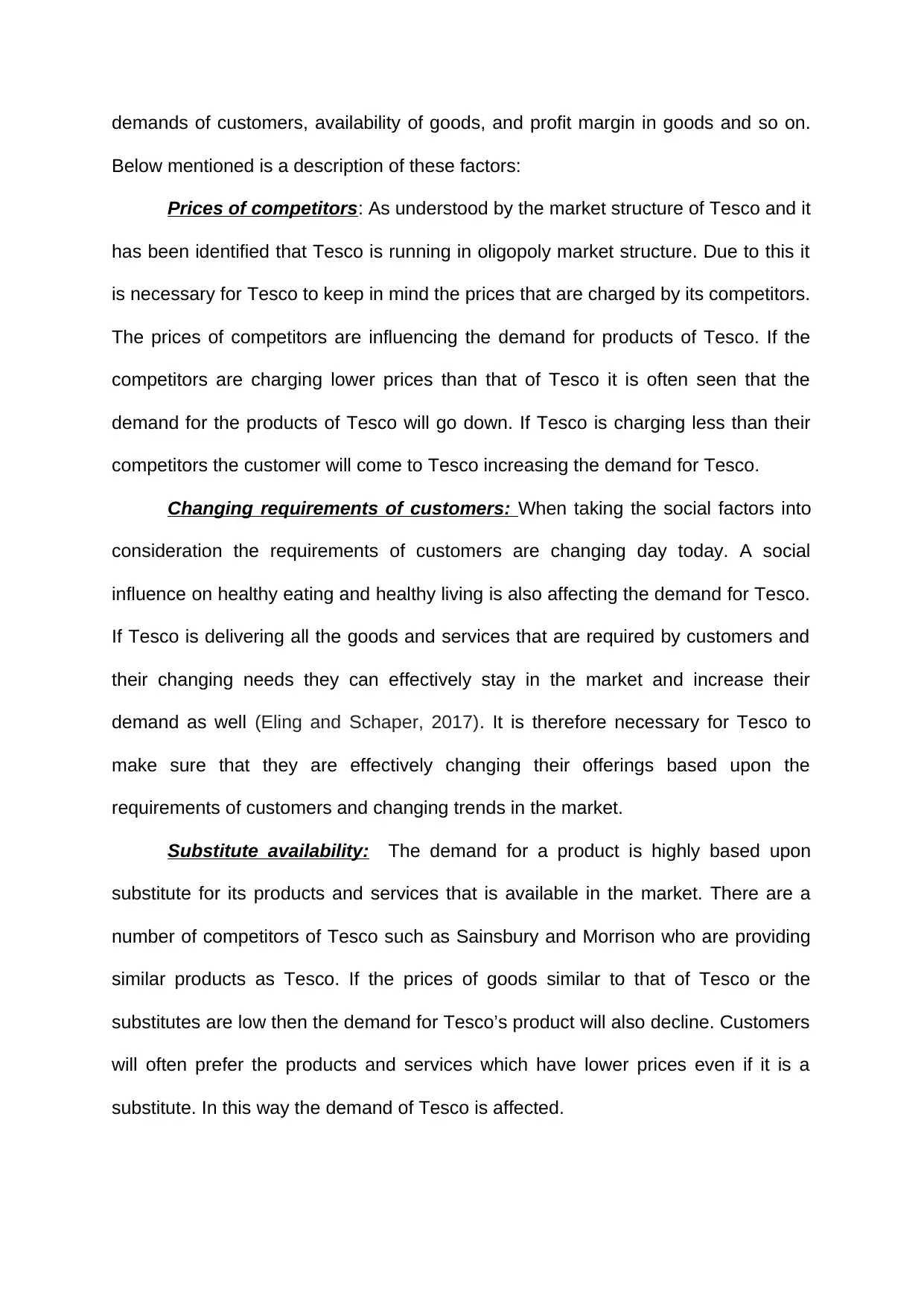
demands of customers, availability of goods, and profit margin in goods and so on.
Below mentioned is a description of these factors:
Prices of competitors: As understood by the market structure of Tesco and it
has been identified that Tesco is running in oligopoly market structure. Due to this it
is necessary for Tesco to keep in mind the prices that are charged by its competitors.
The prices of competitors are influencing the demand for products of Tesco. If the
competitors are charging lower prices than that of Tesco it is often seen that the
demand for the products of Tesco will go down. If Tesco is charging less than their
competitors the customer will come to Tesco increasing the demand for Tesco.
Changing requirements of customers: When taking the social factors into
consideration the requirements of customers are changing day today. A social
influence on healthy eating and healthy living is also affecting the demand for Tesco.
If Tesco is delivering all the goods and services that are required by customers and
their changing needs they can effectively stay in the market and increase their
demand as well (Eling and Schaper, 2017). It is therefore necessary for Tesco to
make sure that they are effectively changing their offerings based upon the
requirements of customers and changing trends in the market.
Substitute availability: The demand for a product is highly based upon
substitute for its products and services that is available in the market. There are a
number of competitors of Tesco such as Sainsbury and Morrison who are providing
similar products as Tesco. If the prices of goods similar to that of Tesco or the
substitutes are low then the demand for Tesco’s product will also decline. Customers
will often prefer the products and services which have lower prices even if it is a
substitute. In this way the demand of Tesco is affected.
Below mentioned is a description of these factors:
Prices of competitors: As understood by the market structure of Tesco and it
has been identified that Tesco is running in oligopoly market structure. Due to this it
is necessary for Tesco to keep in mind the prices that are charged by its competitors.
The prices of competitors are influencing the demand for products of Tesco. If the
competitors are charging lower prices than that of Tesco it is often seen that the
demand for the products of Tesco will go down. If Tesco is charging less than their
competitors the customer will come to Tesco increasing the demand for Tesco.
Changing requirements of customers: When taking the social factors into
consideration the requirements of customers are changing day today. A social
influence on healthy eating and healthy living is also affecting the demand for Tesco.
If Tesco is delivering all the goods and services that are required by customers and
their changing needs they can effectively stay in the market and increase their
demand as well (Eling and Schaper, 2017). It is therefore necessary for Tesco to
make sure that they are effectively changing their offerings based upon the
requirements of customers and changing trends in the market.
Substitute availability: The demand for a product is highly based upon
substitute for its products and services that is available in the market. There are a
number of competitors of Tesco such as Sainsbury and Morrison who are providing
similar products as Tesco. If the prices of goods similar to that of Tesco or the
substitutes are low then the demand for Tesco’s product will also decline. Customers
will often prefer the products and services which have lower prices even if it is a
substitute. In this way the demand of Tesco is affected.
⊘ This is a preview!⊘
Do you want full access?
Subscribe today to unlock all pages.

Trusted by 1+ million students worldwide
1 out of 15
Related Documents
Your All-in-One AI-Powered Toolkit for Academic Success.
+13062052269
info@desklib.com
Available 24*7 on WhatsApp / Email
![[object Object]](/_next/static/media/star-bottom.7253800d.svg)
Unlock your academic potential
Copyright © 2020–2025 A2Z Services. All Rights Reserved. Developed and managed by ZUCOL.





